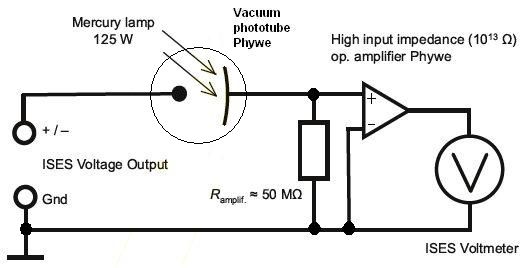Фотоэффект
Эксперимент
Method: Study of the volt-ampere characteristics of a vacuum phototube
When studying the volt-ampere characteristics of a vacuum phototube, the phototube is a part of simple circuit in the figure 5 together with a voltage source and a resistor around 50 megaohms. (The higher resistance, the higher amplification of the photocurrent.) The resistor is connected between the photocathode and the ground (GND). The measurement can be controlled by the user, or the experiment platform ISES provides an automatic scan (using a saw signal at the voltage output).

Fig. 5: Scheme of the electrical circuit.
The voltage on the amplification-resistor is measured by the Phywe high input impedance amplifier (1013 Ω), connected to the module Voltmeter.
Simple cut-off filters at the analog input channels are used for smoothing the signal and for reduction of aliasing. High-quality relays are used for the selection of the amplification-resistor 10–100 megaohms.
A 6-position motorized filter wheel is used for the selection of the wavelength of incident light. Well known wavelengths are due to the usage of high-quality interference filters and a mercury lamp providing five bright spectral lines at 365 nm, 405 nm, 436 nm, 546 nm, and 567 nm.
The mercury lamp (125 W) has a luminophore to reduce the effect of aliasing.
For more details please read User's Manual.
